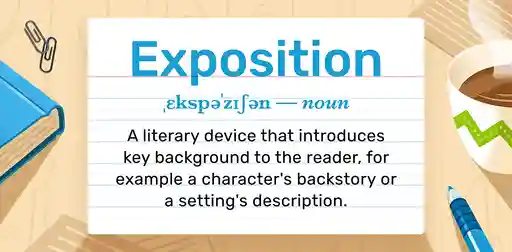Posted on Jan 30, 2023
What is Blackout Poetry? The Ultimate Guide to Erasure Verse
About the author
Reedsy's editorial team is a diverse group of industry experts devoted to helping authors write and publish beautiful books.
More about the Reedsy Editorial Team →Martin Cavannagh
Head of Content at Reedsy, Martin has spent over eight years helping writers turn their ambitions into reality. As a voice in the indie publishing space, he has written for a number of outlets and spoken at conferences, including the 2024 Writers Summit at the London Book Fair.
View profile →Blackout poetry is a type of found or erasure poetry created by taking an existing text — like a newspaper — and erasing or ‘blacking-out’ sections to create a poem from the fragments left behind. The resulting poem is often a commentary on its source and can be satirical, personal, or frivolous in nature.
In recent years, blackout poetry has experienced a surge in popularity, appearing everywhere from Tumblr blogs and school assignments to the pages of literary magazines. To see what the fuss is all about, let’s dive into the history of blackout poetry and see what it takes to make some of your own.
The form may have started as a joke in the 1700s
One of the earliest known examples of blackout poetry can be attributed to Caleb Whiteford, a neighbor of Benjamin Franklin who would redact the local newspaper, replacing serious news with jokes and puns. Whiteford published his creations, distributing them amongst his friends — however, it wasn’t seen as a serious literary endeavor but more of a fun lark amongst intellectuals.

For another hundred years or so, things were all quiet on the blackout poetry front — until the Dadaists came on the scene in the early 20th century.
Entrenched in surrealism and absurdism, the Dada movement created strange and irrational art as a response to the senseless slaughter of the First World War. One of the ways they did this was by playing with language. Using a collaging technique, they rearranged words in texts until they became something new and weird. Tristan Tzara, one of the movement's founders, took a meta approach to the form and even wrote a poem about how to make Dadaist poems using scissors.
This tradition of chopping and interchanging words continued with the Beat poets of the 1960s, primarily William S. Burroughs. Though Burroughs also worked in cut-up poetry, he was more deliberate in arranging his words with published works such as the Nova trilogy.
Many works of erasure or blackout poetry came in the following decades from different artistic movements. Among them were Ronald Johnson’s RADI OS, an erasure poem of John Milton’s Paradise Lost, and Tom Phillips’ A Humument, a painted collage of Victorian author William Hurrell Mallock’s, A Human Document.
A Humument’s title comes from a deletion of Mallock’s title, firmly establishing this as a work of erasure verse. This work is interesting, particularly because Phillips has been working on it continuously since 1966. Its first iteration was published in 1973, and a second edition with new iterations and developments was published in 2010.
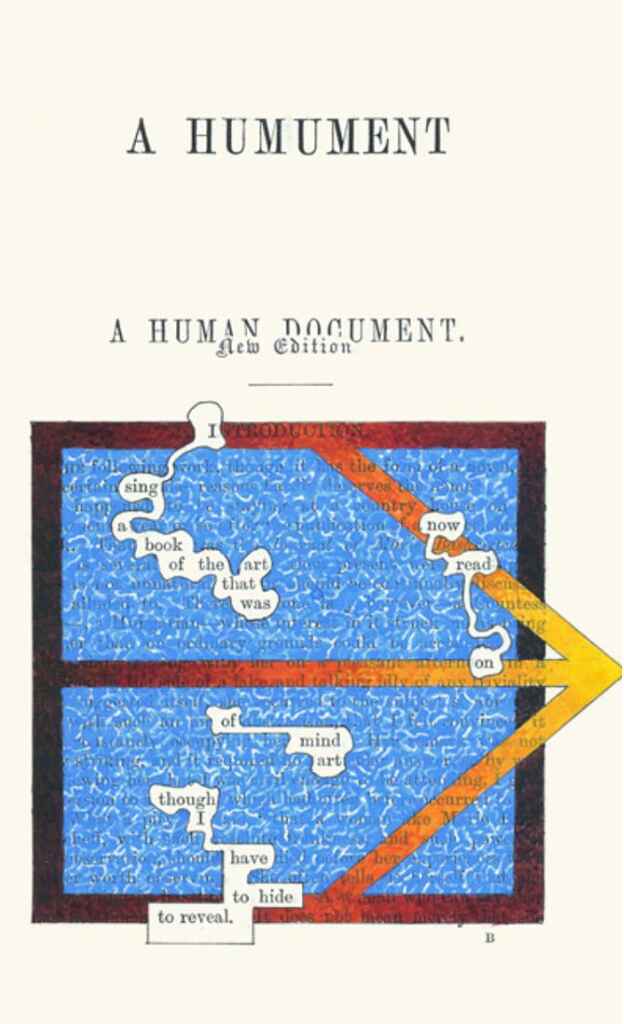
A Humument uses many techniques of erasure verse to create a work that is truly an amalgamation of the literary and aesthetic. Phillips employs collage, cut-ups, and paint to redo the entirety of this obscure text.
As it’s been in development for so long, it’s an interesting way to see how blackout poetry has evolved over the years as it uses techniques popularized by the Beats and more modern techniques as well.
Since Benjamin Franklin’s time, erasure writing has gone from being a fun game played among friends to a serious art form that comments on society, as we can see in some of the ways blackout poetry is used now.
Blackout poems are often statements on censorship
The visual element of blackout poetry recalls redacted text of government documents and letters home from soldiers at war. This resemblance has led to the form being commonly used to comment on the very act of censorship. This is often done with a text that is frequently censored or banned. Using erasure, words are blacked out, but what’s left behind isn’t a sanitized version. Rather, it’s more honest or blunt, flipping the idea of censorship on its head and making the reader see the truth.
While a news article might tiptoe around the issue, a poet may take that text and redact it so the message is raw and unyielding. A communique from the government, official and stiff, can become an indictment of inaction when censored by a poet.
Example: “Media Blackout”, poem for Burma by M.A. Dubbs
Made from an announcement from the U.S. Embassy in Burma on September 9, 2021 entitled “Message to U.S. Citizens”, poet M.A. Dubbs comments on censorship in Burma/Myanmar following a government coup and many years of state-sponsored genocide.
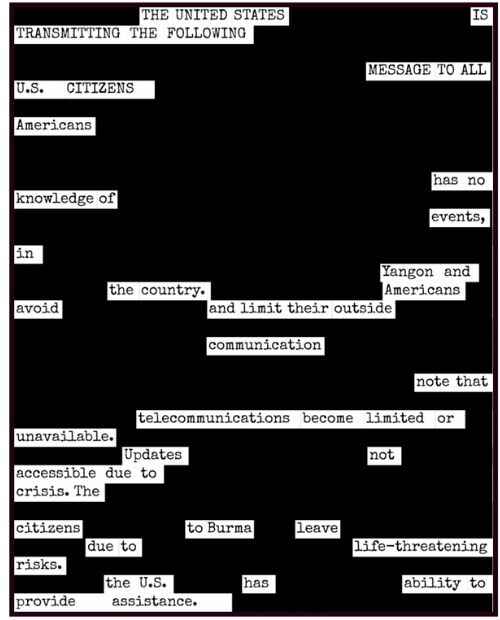
The poem reads:
The United States is transmitting
The following message to all U.S. citizens
Americans has no knowledge of events,
In Yangon and the country.
Americans avoid and limit their outside communication
Note that telecommunications become limited or unavailable.
Updates not accessible due to crisis.
The citizens to Burma leave due to life-threatening risks.
The U.S. has ability to provide assistance.
Dubbs uses the source material, which warns U.S. citizens about the dangers of traveling to Burma, to draw attention to the fact that the United States is turning a blind eye to what’s happening in that country. The last sentence serves as a call to action, urging the United States to intervene.
Using blackout poetry, Dubbs pointedly comments on the laundering of information that both the Burmese and American governments are engaged in. It’s a powerful way to comment on injustices, and the U.S government’s refusal to speak the truth on this matter.
As M.A. Dubbs shows, blackout poetry is a great way to say something about important topics — though it’s certainly not limited to censorship.
They are capable of political and emotional depths
As with any kind of poetry, erasure verse is at its most potent when it’s trying to say something. The potential topics are unlimited and this form is just as capable of plumbing the depths of the human psyche and imperfect institutions as any other.
Example: “Form N-400 Erasures” by Niina Pollari
Finnish-born poet Niina Pollari uses blackout technique to explore the complicated feelings that arise during the immigration process by redacting “Form N-400, Application for Naturalization.” In blacking out this piece of paperwork required to become a naturalized U.S. citizen, the poem starts by asking:
Do you / Have / awful / association / s / Have you / been / in / total / terror.
Leaving the 'yes' or 'no' checkbox exposed creates an uneasy mixture of the mundane and the harrowing, which might be an apt way to describe the issue of immigration.
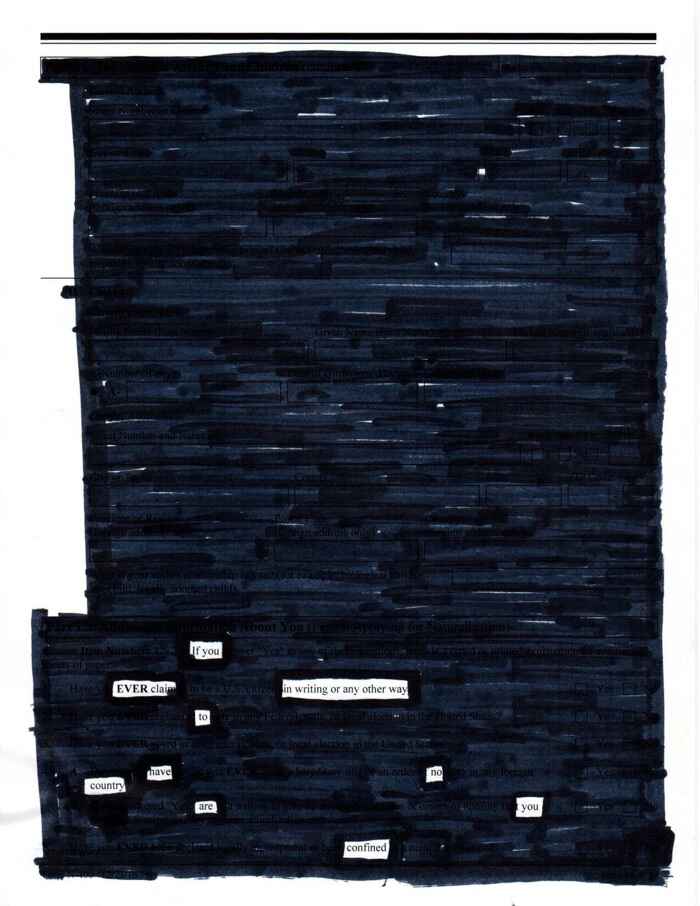
Pollari’s choice of source material is crucial here. With the assumption that Pollari will likely have had to complete this form at some point, it’s clear she’s talking about the fear and uncertainty of moving to another country and abandoning your previous one. Using strong, evocative language, she brings up the feeling of fear one might experience as they fill out this form. By redacting everything but the most descriptive words, she takes what can be a boring procedural task and turns it into an emotional struggle about leaving behind your country of origin.
Erasure verse lets you make even the most unappealing of documents into hard-hitting poetry and the best part is, there’s more than one way to do it.
It’s a form that is still evolving
The classic image of blackout poetry is of black bars obscuring text like a secret CIA document. However, recent years have seen innovations in the form that go beyond that. Tom Phillips was a pioneer in this sense, combining art and erasure verse. In A Humument, he made a whole book where the act of erasure was artistic.
Many poets and artists are now employing this same technique, using the text to literally create an image, allowing the act of erasure to be beautiful rather than an oppressive wall of blunt black boxes.
Example: “Stars” by Jewel Guerra
Created for the 2019 New York Times Blackout Poetry Contest, then-16-year-old Jewel Guerra wrote a poem using a page from the print edition of The New York Times. Musing on the beauty of space, she uses a technique called “mapping” that makes blackout poetry into a work of art.
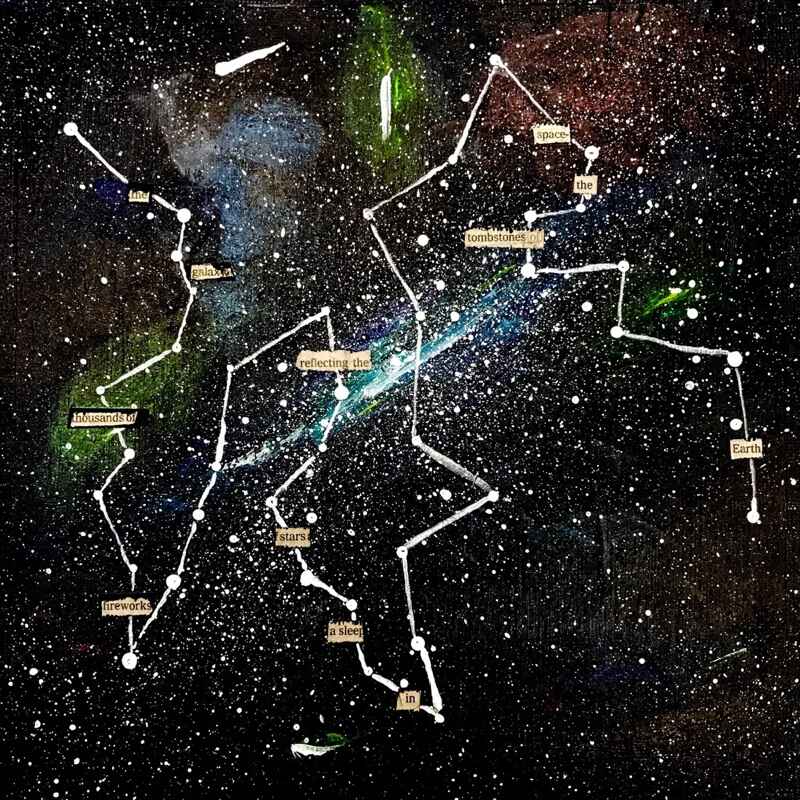
Guerra connects the message of her piece — space — with the visual aspect of her poem by creating a constellation with the words. The words are not read sequentially as is usually done with blackout poetry, but connected by lines. It’s kind of like literary connect the dots.
Set against a backdrop of stars and comets, this gives the piece a sense of intentionality. Rather than just finding the words on the page, it feels like they were meant to exist like this, set in this order.
This poem takes advantage of the fact that blackout poetry is a very visual form. The way words are redacted or erased has as much impact on the piece as the words themselves. It shows that each new generation of poets has a different relationship with the medium than the previous ones.
Print text doesn’t mean the same thing to poets now — so what will be their equivalent of erasure poetry? That still remains to be seen, but the works of poets like Jewel Guerra show us the possibilities.
💡Want to learn more about designing poetry? Check out this post about poetry book layouts!
To make blackout poetry, all you need is a source and black pen
Earlier, Tristan Tzara gave us a pretty good idea of how you can make blackout poetry. But unless you want to take a Dadaist nonsense approach, you probably want to decide what words to use. Overall, the process is fairly simple.
How to make blackout poetry:
1. Pick a source that means something to you
As we’ve discussed, the text you choose to work with is important. Blackout poetry is often in conversation with its source, so you really want to consider what you want to say before you get started.
2. Choose your words carefully
This is where you spend time brainstorming your poem. There’s no right or wrong way to do this, but starting with an idea is always good. Consider what emotions you want to evoke or topics you want to explore, then search for the right words.
As you do this, think about what technique you want to use. Do you want to go for classic sequential redacting? Experiment with mapping? Try something else entirely? The world truly is your oyster here.
3. Black out the rest
Or white it out. Or map it out. Or draw a picture of a rabbit.
Once you’ve organized your ideas, all that’s left to do is make your poem. That’s really all there is to it!
Blackout poetry is an incredibly flexible form and one that’s still evolving. It can be a great way for writers to experiment, and it can be a great way to combat writer’s block. Turning to a different creative outlet and having fun can get your mental machinery working again.
We hope this post taught you a thing or two about blackout poetry. Now you can confidently go out into the world and make erasure verse out of anything — maybe even this post!





